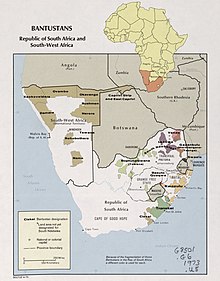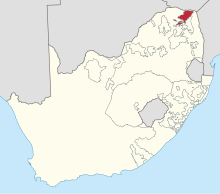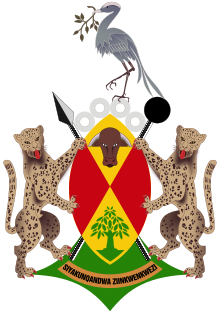List of leaders of the TBVC states

This article lists the leaders of the TBVC states, the four Bantustans which were declared nominally independent by the government of the Republic of South Africa during the period of apartheid, which lasted from 1948 to 1994. Their independence was not recognized outside South Africa.
The bantustans with nominal independence were namely: Transkei (1976[1][2]), Bophuthatswana (1977[3][4]), Venda (1979[5][6]) and Ciskei (1981[7][8]), hence the abbreviation TBVC.
The TBVC states were reintegrated into South Africa after the first post-apartheid general election in 1994.[9]
List[]
Transkei[]

Map of Transkei (red) within South Africa.

Coat of arms of the Republic of Transkei (Xhosa: iRiphabliki yeTranskei).
Heads of state[]
| Tenure | Portrait | Incumbent | Party | Notes |
|---|---|---|---|---|
| Presidents | ||||
| 26 October 1976 to 1 December 1978 | Botha Sigcau | TNIP | Died in office[10] | |
| 1 December 1978 to 19 February 1979 | TNIP | Acting | ||
| 19 February 1979 to 20 February 1986 | Kaiser Daliwonga Matanzima | TNIP | Retired | |
| 20 February 1986 to 26 April 1994 | TNIP/n-p | |||
Heads of government[]
| Tenure | Portrait | Incumbent | Party | Notes |
|---|---|---|---|---|
| Chief Minister | ||||
| 6 December 1963 to 26 October 1976 | Kaiser Daliwonga Matanzima | TNIP | ||
| Prime Ministers | ||||
| 26 October 1976 to 20 February 1979 | Kaiser Daliwonga Matanzima | TNIP | Become President | |
| 20 February 1979 to 24 September 1987 | George Mzivubu Matanzima | TNIP | Brother of Kaiser Daliwonga Matanzima; resigned[11] | |
| 25 September 1987 to 5 October 1987 | TNIP | Acting | ||
| 5 October 1987 to 30 December 1987 | Stella Sigcau | TNIP | Daughter of Botha Sigcau; deposed in a coup d'état[12][13] | |
| Head of the Military Council | ||||
| 30 December 1987 to 26 April 1994 | Bantu Holomisa | TDF (military) |
||
Foreign ministers[]
Source: [14]
- 1976–1980:
- 1980–1983:
- 1983–1986:
- 1986–1988:
- 1988–1989:
- 1989–1992:
- 1992–1994: Bantu Holomisa
Bophuthatswana[]

Map of Bophuthatswana (red) within South Africa.

Coat of arms of the Republic of Bophuthatswana (Tswana: Repaboleki ya Bophuthatswana).
Heads of state and government[]
| Tenure | Portrait | Incumbent | Party | Notes |
|---|---|---|---|---|
| Chief Executive Officer | ||||
| June 1968 to 1 May 1971 | Lucas Mangope | Tswana Territorial Authority | ||
| Chief Executive Councillor | ||||
| 1 May 1971 to 1 June 1972 | Lucas Mangope | |||
| Chief Minister | ||||
| 1 June 1972 to 6 December 1977 | Lucas Mangope | BNP/ | ||
| President | ||||
| 6 December 1977 to 13 March 1994 | Lucas Mangope | BDP/ | Forced to flee during the 1994 crisis[15] | |
| (10 February 1988) (Hours) | Rocky Malebane-Metsing | In rebellion staged by members of the BDF (military). Coup attempt crushed by the SADF troops[16] | ||
| Administrators (Transitional Executive Council) | ||||
| 13 March 1994 to 26 April 1994 | Tjaart van der Walt | |||
| Job Mokgoro | ||||
Foreign ministers[]
Source: [14]
- 1977–1987:
- 1987–1990:
- 1990–1991:
- 1991–1994:
Venda[]

Map of Venda (red) within South Africa.

Coat of arms of the Republic of Venda (Venda: Riphabuliki ya Venda).
Heads of state and government[]
| Tenure | Portrait | Incumbent | Party | Notes |
|---|---|---|---|---|
| Chief Executive Officer | ||||
| June 1969 to 1 June 1971 | Patrick Mphephu | Venda Territorial Authority | ||
| Chief Executive Councillor | ||||
| 1 June 1971 to 1 February 1973 | Patrick Mphephu | |||
| Chief Minister | ||||
| 1 February 1973 to 13 September 1979 | Patrick Mphephu | NPV | ||
| Presidents | ||||
| 13 September 1979 to 17 April 1988 | Patrick Mphephu | NPV | Died in office[17] | |
| 17 April 1988 to 5 April 1990 | Frank Ravele | NPV | Acting until 10 May 1988; deposed in a coup d'état[18] | |
| Heads of State (Chairmen of the Council of National Unity) | ||||
| 5 April 1990 to 25 January 1994 | Gabriel Ramushwana | VDF (military) |
||
| 25 January 1994 to 26 April 1994 | VDF (military) |
|||
Foreign ministers[]
Source: [14]
- 1979–1980:
- 1980–1986:
- 1986–1989:
- 1989–1990:
- 1990–1992:
- 1992–1994:
- 1994: Gabriel Ramushwana
Ciskei[]

Map of Ciskei (red) within South Africa.

Coat of arms of the Republic of Ciskei (Xhosa: iRiphabliki ye Ciskei).
Heads of state and government[]
| Tenure | Portrait | Incumbent | Party | Notes |
|---|---|---|---|---|
| Chief Executive Officer | ||||
| June 1968 to 1 June 1971 | Thandatha Jongilizwe Mabandla | Ciskei Territorial Authority | ||
| Chief Executive Councillor | ||||
| 1 June 1971 to 1 August 1972 | Thandatha Jongilizwe Mabandla | |||
| Chief Ministers | ||||
| 1 August 1972 to 21 May 1973 | Thandatha Jongilizwe Mabandla | CNP | ||
| 21 May 1973 to June 1975[19] | Lennox Sebe | Gained power in the 1973 election; 1st term | ||
| June 1975[19] to 24 October 1975[19] | Charles Sebe | CDF (military) |
Brother of Lennox Sebe; acting | |
| 24 October 1975[19] to 4 December 1981 | Lennox Sebe | CNIP | Proclaimed independence following the 1980 referendum; 2nd term | |
| President | ||||
| 4 December 1981 to 4 March 1990 | Lennox Sebe | CNIP | Declared President for life in 1983; deposed in a coup d'état[20] | |
| Chairman of the Military Committee and of the Council of State | ||||
| 4 March 1990 to 22 March 1994 | Oupa Gqozo | CDF (military) (from 1991) |
Resigned[21] | |
| Administrators (Transitional Executive Council) | ||||
| 23 March 1994 to 26 April 1994 | ||||
Foreign ministers[]
Source: [14]
- 1981–1983: Ray Mali
- 1983–1990:
- 1990–1991:
- 1991–1993: Oupa Gqozo
- 1993:
- 1993–1994:
See also[]
- Bantu Authorities Act, 1951
- Promotion of Bantu Self-government Act, 1959
- Bantu Homelands Citizenship Act, 1970
- Bantu Homelands Constitution Act, 1971
References[]
- ^ The Status of Transkei Act 100 of 1976 granted Transkei "independence" with effect from 26 October 1976.
- ^ "Transkei, a South African Black Area, Is Independent". The New York Times. 26 October 1976. Retrieved 1 April 2019.
- ^ The Status of Bophuthatswana Act 89 of 1977 granted Bophuthatswana "independence" with effect from 6 December 1977.
- ^ "An Empty Ceremony in South Africa". The New York Times. 6 December 1977. Retrieved 1 April 2019.
- ^ The Status of Venda Act 107 of 1979 granted Venda "independence" with effect from 13 September 1979.
- ^ "South Africa Starts a New Nation". The New York Times. 14 September 1979. Retrieved 1 April 2019.
- ^ The Status of Ciskei Act 110 of 1981 granted Ciskei "independence" with effect from 4 December 1981.
- ^ "CISKEI 'HOMELAND' DECLARED A SEPARATE NATION". The New York Times. 4 December 1981. Retrieved 1 April 2019.
- ^ All Bantustans (both nominally independent and self-governing) were dismantled and their territories reincorporated into South Africa with effect from 27 April 1994, in terms of section 1(2) and Schedule 1 of the Constitution of the Republic of South Africa, 1993, the so-called "Interim Constitution" which abolished apartheid in South Africa. The text of this Interim Constitution, which came into force on 27 April 1994, coinciding with the beginning of the first democratic elections, is available online at Constitution of the Republic of South Africa, 1993 as of 27 April 1994.
- ^ "Chief Botha Sigcau, 66, First Transkei President". The New York Times. 2 December 1978. Retrieved 2 April 2019.
- ^ "Six Cabinet Ministers Resign in Transkei Scandal". The New York Times. 25 September 1987. Retrieved 1 April 2019.
- ^ "Army Coup in South African Homeland". The New York Times. 31 December 1987. Retrieved 1 April 2019.
- ^ "Army Stages Coup in Black S. Africa Area: General Takes Over in Transkei Region, Charges Corruption". The Los Angeles Times. 30 December 1987. Retrieved 6 April 2019.
- ^ a b c d "Foreign ministers S-Z". rulers.org. B. Schemmel. Retrieved 15 April 2019.
- ^ "A Homeland's Agony". The New York Times. 13 March 1994. Retrieved 1 April 2019.
- ^ "South Africa Quells Coup Attempt in a Homeland". The New York Times. 11 February 1988. Retrieved 1 April 2019.
- ^ "Patrick Mphephu, Homeland Leader, 63". The New York Times. 21 April 1988. Retrieved 2 April 2019.
- ^ "Security forces stage coup in S. African homeland". UPI Archives. 5 April 1990. Retrieved 1 April 2019.
- ^ a b c d Elections in South Africa's Apartheid-Era Homelands "Bantustans" African Elections Database
- ^ "'HOMELAND' LEADER DEPOSED IN CISKEI". The New York Times. 5 March 1990. Retrieved 1 April 2019.
- ^ "A 2d Homeland Is Taken Over By South Africa". The New York Times. 23 March 1994. Retrieved 2 April 2019.
External links[]
- ^ The dates and designations given on the sites World Statesmen and Rulers are partially inaccurate.
Categories:
- Political office-holders in the South African bantustans
- Heads of state of South African bantustans
- Chief ministers of South African bantustans
- South Africa history-related lists
- Lists of South African people